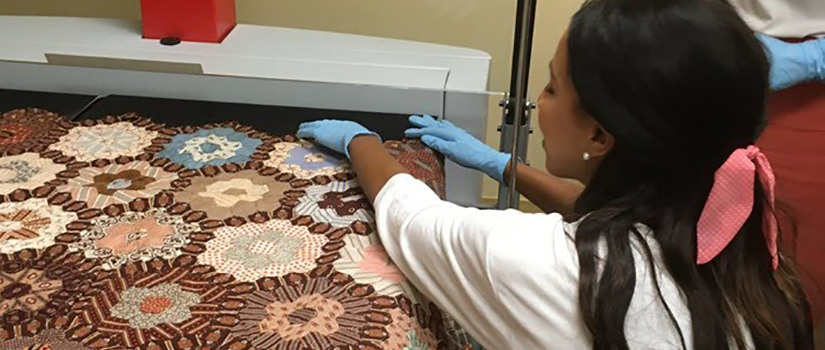UofSC Libraries Digital Collections permanently preserve historical artifacts threatened by time
It took six people three days to digitally scan, section by section, a delicate, Victorian-era quilt top owned by McKissick Museum.
It then took Chauna Carr three months to knit the images together in Photoshop, reconstructing the quilt digitally.
Carr worked for four years with UofSC Libraries Digital Collections, first as a graduate student worker in the College of Information and Communications, then as full-time library staff after she got her degree.
So why would you scan a quilt?
“Digital collections serve to capture history,” says Mēgan Oliver, Digital Collections librarian.
“When someone brings us an artifact like the quilt, we scan it because it’s incredibly unique and is a primary source that isn’t replicated somewhere else online. It’s an artifact that students and faculty can engage with easily,” she says.
“Our work preserves artifacts digitally, so our work essentially preserves them in a format that will bring them to life permanently and in a format that can be easily shared around the world,” Oliver says.
And all artifacts, at some point in time, will disintegrate.
Digital Collections not only scans items, but also creates the information known as metadata that describes all the images, which allows them to come up in a keyword search and provide rich historical information for researchers.
“We’re heavy producers, scanning and creating metadata for about 25,000 items per quarter, and we work quickly. We’re about to reach a tremendous two-decade milestone, and our output has been incredible,” says Oliver.
These are some of the more than 300 digitized collections you can explore:
- The Anne Farr Hardin Collection of Ray Bradbury, the Libraries’ most comprehensive single-author collection
- Justice for All, South Carolina’s civil rights leaders and activists
- Curious like Catesby, showcases the works of naturalist and artist Mark Catesby
- South Carolina Veterans Oral History Collection, the lives and experiences of South Carolina veterans
- U.S. Marine Corps Film Repository, a collection of films housed at Quantico, Virginia for generations
Since the department’s inception 17 years ago, Digital Collections’ student workers and department staff have processed items ranging from historical photos, books, documents, newspapers, maps, postcards, portraits, scrapbooks to quilts.
Some highlights of the department’s accomplishments include:
- More than one million items scanned
- 300 digital collections online
- 2,254,350 images viewed by users in the past year
- 19,777 users in 150 countries outside the U.S.
More than 60 students have passed through the department throughout the years, and most of them have gone on to work in other archival or digital collections positions. Carr, for example, recently accepted a position as digitization archivist at the North Carolina Department of Natural and Cultural Resources.
“Not only did my work at Digital Collections give me the skills for the position I have now, it also prepared me to work in a professional environment, take on responsibility and work in a leadership position," Carr says.
“I learned how to work with other people, work within a team and manage the moving parts of project. It has all been so helpful in how I now navigate through office situations. It was a wonderful learning experience,” she says.
Oliver says Digital Collections has a long history of fostering student employees who then become part- or full-time employees who work with them for many years.
“We really serve as a springboard before they move on to the next professional position,” she says.
While the students have been a constant at Digital Collections through the years, the technology and best practices have evolved, says Kate Boyd, Digital Collections director.
“After 17 years of creating and bringing collections online, we are seeing an effort to add more metadata and transcriptions to the collections. We are also becoming more strategic in planning what collections should focus on. And we’re improving access to different file formats through new page-turning features and video and audio streaming,” says Boyd.
“Both the technology and the work are very exciting,” she says.
Carr agrees.
“Everything about it is fun, the scanning, creating metadata, even spending three months constructing a single image — because it will last forever,” she says.
